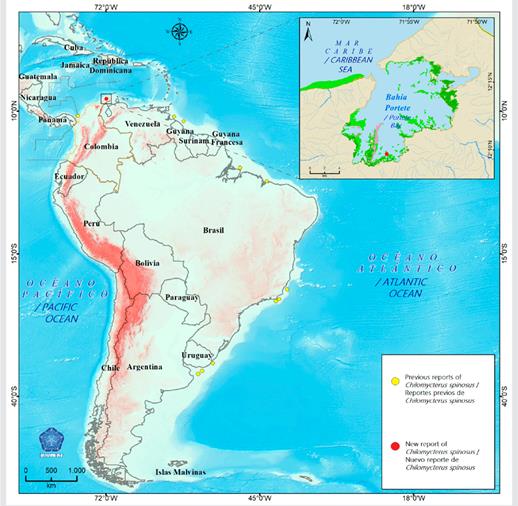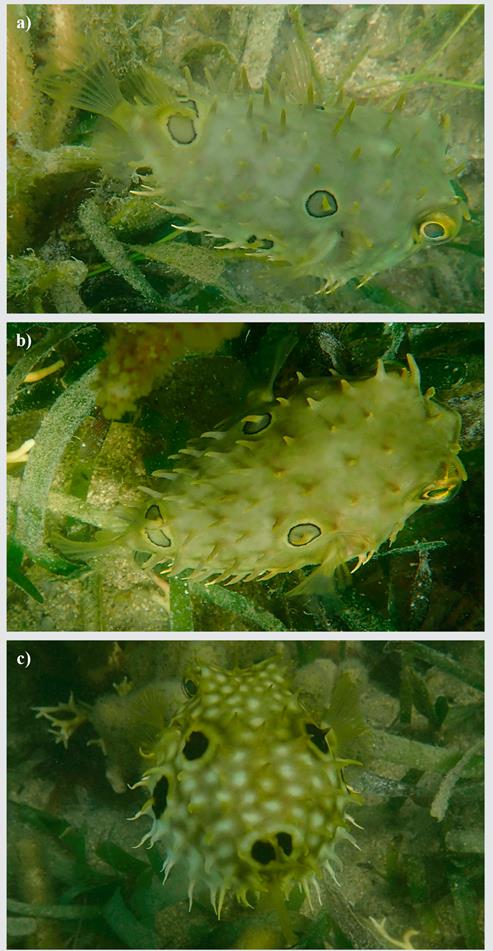Notes
Confirmation of the presence of the brown burrfish Chilomycterus spinosus (Diodontidae) in the Colombian Caribbean
Confirmación de la presencia del pez globo Chilomycterus spinosus (Diodontidae) en el Caribe colombiano
1Instituto de Investigaciones Marinas y Costeras, Invemar. Calle 25 No 2-55, El Rodadero, Santa Marta, Colombia.
2Departamento de Biología, ETH Zúrich, Suiza.
3Instituto de Investigaciones Marinas y Costeras, Invemar. Calle 25 No 2-55, El Rodadero, Santa Marta, Colombia.
ABSTRACT
The presence of the brown burrfish Chilomycterus spinosus (Diodontidae) in the Colombian Caribbean is confirmed. An individual of this species was sighted in August 2022 in Portete Bay at a depth of 1.5 m. An expansion of the depth range of this species is reported to shallower areas.
Keywords: seagrass meadows; Portete Bay; reef fishes
RESUMEN
Se confirma la presencia en el Caribe colombiano del pez globo Chilomycterus spinosus perteneciente a la familia Diodontidae. Un individuo de esta especie fue avistado en agosto de 2022 en bahía Portete a una profundidad de 1,5 m. Se registra una variación en el rango de profundidad de esta especie a zonas más someras.
Palabras clave: pastos marinos; bahía Portete; peces arrecifales
The family Diodontidae, with 75 reported species (Leis, 2006). is widely distributed in tropical waters, having a relatively common presence in different marine ecosystems. The genus Chilomycterus is a group of fishes widely distributed in the tropical Atlantic and Indo-Pacific Oceans (Acero and Polanco, 2006; Garrido et al., 2014). Three species of this genus have been reported from Colombia, of which Chilomycterus antennatus (Cuvier) and C. antillarum (Jordan & Rutter) are found in the Caribbean, while C. reticulatus (Linnaeus) can be found in both Caribbean and Pacific (Acero and Garzón, 1987; Rubio, 1987; Medina et al., 2001). The presence of the brown burrfish, Chilomycterus spinosus (Linnaeus, 1758), in Colombia has not been fully confirmed previously, considering that the only official record corresponds to one made in the Global Biodiversity Information Facility (GBIF) by the Florida Museum of Natural History (Robins, 2023), with a specimen registered in 1970 towards the border area between Colombia and Panama (Punta Caribaná).
On August the 19th, 2022, one individual of the brown burrfish was sighted in Portete Bay, Colombian Caribbean (12° 9’ 42.04” N-71° 56’ 37.86” W). This place, located at the north of La Guajira department, is a shallow bay, with an average depth of 9 m, presenting high salinity due to the scarce runoff (Gutiérrez-Moreno et al., 2008). On the coast there is a wide presence of mangrove forests and seagrass meadows (Díaz et al., 2003), while the coral formations are limited to the southwestern side of the bay, at about 4 m deep (Solano, 1994; Gutiérrez-Moreno et al., 2008). The reported individual was found in the southern area of the bay, in a spot dominated mainly by seagrass meadows, at an approximate depth of 1.5 m (Figure 1).
The coloration pattern of the reported specimen (Figure 2) correspond to the literature information for C. spinosus, presenting an absence of lines and black dots along the body and fins, length of spines less than the orbital diameter, and presence of three defined spots above and below the pectoral fins as well as below the dorsal fin (Figueiredo and Menezes, 2000; Sampaio and Nottingham, 2008). These characters clearly differentiate it from the other species reported in the area and allow a visual identification of the individual.
On the other hand, the depth where the specimen was found (1.5 m) differs from reports by Figueiredo and Menezes (2000), where a range between 70 and 190 m depth is mentioned. Other authors, such as Robertson and Van Tassell (2019), describe a range from 0 to 200 m, similar to the data from Santos et al. (2015) and Pereira et al. (2019), where individuals of C. spinosus were captured in estuaries near the coast of Brazil, at depths close to 5 m. These data show a variation in the depth range of the species and reflect a presence of this organism in shallower waters. The confirmation of the presence of this species, represents a contribution to the country’s fish diversity, as well as an expansion of its distribution to the southwestern Caribbean.
ACKNOWLEDGMENTS
The authors thank the staff of the Bahía Portete-Kaurrele National Natural Park for their support in the area, as well as Laura Sánchez and Elizabeth Galeano from Invemar, for their cooperation with the images. This is the contribution #1365 of the Institute of Marine and Coastal Research-Invemar.
LITERATURE CITE
Acero P A, Garzón F J. Peces arrecifales de la región de Santa Marta (Caribe colombiano). I. Lista de especies y comentarios generales. Acta Biol Col. 1987;1383-105.
[ Links ]
Acero P. A, Polanco F A. Peces del orden Tetraodontiformes de Colombia. Biota Col. 2006;71155-164.
[ Links ]
Díaz JM, Barrios LM, Gómez-López DI. Las praderas de pastos marinos en Colombia: estructura y distribución de un ecosistema estratégico. Ser Publ Espec Invemar; 10; 159 p. 2003.
[ Links ]
Figueiredo JL, Menezes NA. Manual de peixes marinhos do sudeste do Brasil. VI. Teleostei (5). São Paulo: Museu de Zoologia, Univ São Paulo; 2000. 116 p.
[ Links ]
Garrido A, Ibáñez-Yuste AJ, Norman C, Terrón-Sigler A. First record of Chilomycterus spinosus mauretanicus (Osteichthyes: Diodontidae) in the Mediterranean Sea. Mar Biodivers Rec. 2014;779.
[ Links ]
Gutiérrez-Moreno C, Alonso D, Segura-Quintero C. Diseño de un área marina protegida para bahía Portete-La Guajira, Caribe colombiano. Bol Invest Mar Cost. 2008;72189-212.
[ Links ]
Leis JM. Nomenclature and distribution of the species of the porcupinefish family Diodontidae (Pisces, Teleostei). Mem Mus Victoria. 2006;63177-90.
[ Links ]
Medina J, Acero P A, Viaña T J, Manjarrés L. Primer registro de Chylomycterus reticulatus (Linnaeus) (Pisces: Tetraodontiformes: Diodontidae) para el Caribe colombiano. Bol Invest Mar Cost. 2001;30213-218.
[ Links ]
Pereira TSB, Del Arco A, Hoffmann P, Marques VB. Anatomical characterization of the digestive system of the pufferfish (Chilomycterus spinosus spinosus). Acta Scientiarum Biol. 2019;41e44645-e44645.
[ Links ]
Robertson, DR,Van Tassell, J. Shorefishes of the Greater Caribbean: online information system. Version 2.0. Smithsonian Tropical Research Institute; Balboa, Panamá. 2019.
[ Links ]
Robins R. UF FLMNH Ichthyology. Version 117.407. Florida Museum of Natural History. 2023.
https://doi.org/10.15468/8mjsel
accessed via GBIF.org on 2023-09-06
[ Links ]
Rubio E, Gutiérrez B, Franke R. Peces de la isla Gorgona. Cali: Univ Valle; 1987. 315 p.
[ Links ]
Sampaio CL, Nottingham MC. Guia para identificação de peixes ornamentais brasileiros: espécies marinhas: volume 1. Ibama; 2008.
[ Links ]
Santos SR, Andrade ACD, Verani JR, Vianna M. Population explosion of the burrfish Chilomycterus spinosus spinosus (Diodontidae, Tetraodontiformes) in a eutrophic tropical estuary. Mar Biol Res. 2015;119955-964.
[ Links ]
Solano OD. Corales, formaciones arrecifales y blanqueamiento de 1987 en bahía Portete (Guajira, Colombia). An Inst Mar Punta Betín. 1994;23149-163.
[ Links ]













 text in
text in 



